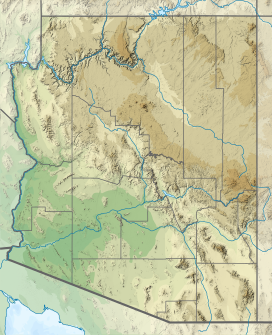
The geology of the Grand Canyon area includes one of the most complete and studied sequences of rock on Earth. The nearly 40 major sedimentary rock layers exposed in the Grand Canyon and in the Grand Canyon National Park area range in age from about 200 million to nearly 2 billion years old. Most were deposited in warm, shallow seas and near ancient, long-gone sea shores in western North America. Both marine and terrestrial sediments are represented, including lithified sand dunes from an extinct desert. There are at least 14 known unconformities in the geologic record found in the Grand Canyon.
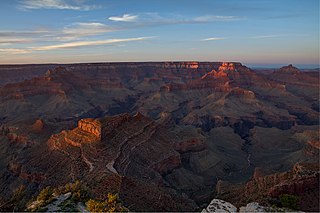
Newton Butte, in the Grand Canyon, Arizona, United States is a prominence below the South Rim, northwest of Grandview Point, and north on a ridgeline from Shoshone Point which is one mile east of Yaki Point, East Rim Drive. Shoshone Point and Yaki are both on access roads from East Rim Drive, with Yaki being the more advantageous to different viewing directions.

The Tonto Group is a name for an assemblage of related sedimentary strata, collectively known by geologists as a Group, that comprises the basal sequence Paleozoic strata exposed in the sides of the Grand Canyon. As currently defined, the Tonto groups consists of the Sixtymile Formation, Tapeats Sandstone, Bright Angel Shale, Muav Limestone, and Frenchman Mountain Dolostone. Historically, it included only the Tapeats Sandstone, Bright Angel Shale, and Muav Limestone. Because these units are defined by lithology and three of them interfinger and intergrade laterally, they lack the simple layer cake geology as they are typically portrayed as having and geological mapping of them is complicated.

The Middle Permian Toroweap Formation is a thin, darker geologic unit, between the brighter colored units of the Kaibab Limestone above, and Coconino Sandstone below. It is a prominent unit in Grand Canyon, Arizona, Southwestern United States, found through sections of the South Rim, Grand Canyon, and the North Rim, of the Kaibab Plateau; also the Kaibab's southeast extension to Cape Royal, the Walhalla Plateau. The Colorado River of the Grand Canyon makes its excursion from due-south to due-west around the Walhalla Plateau, as it enters the east end of the Grand Canyon's interior, Granite Gorge. The formation is also found in southeast Utah.

Isis Temple is a prominence in the Grand Canyon, Arizona, Southwestern United States. It is located below the North Rim and adjacent to the Granite Gorge along the Colorado River. The Trinity Creek and canyon flow due south at its west border; its north, and northeast border/flank is formed by Phantom Creek and canyon, a west tributary of Bright Angel Creek; the creeks intersect about 3 mi (4.8 km) southeast, and 1.0 mi (1.6 km) north of Granite Gorge. The Isis Temple prominence, is only about 202 ft (62 m) lower than Grand Canyon Village, the main public center on Grand Canyon’s South Rim.

The Grand Canyon Supergroup is a Mesoproterozoic to a Neoproterozoic sequence of sedimentary strata, partially exposed in the eastern Grand Canyon of Arizona. This group comprises the Unkar Group, Nankoweap Formation, Chuar Group and the Sixtymile Formation, which overlie Vishnu Basement Rocks. Several notable landmarks of the Grand Canyon, such as the Isis Temple and Cheops Pyramid, and the Apollo Temple, are surface manifestations of the Grand Canyon Supergroup.
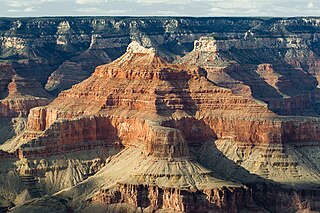
The Lower Permian Esplanade Sandstone is a cliff-forming, resistant sandstone, dark red, geologic unit found in the Grand Canyon. The rock unit forms a resistant shelf in the west Grand Canyon, south side of the Colorado River, at the east of the Toroweap Fault, down-dropped to west, southeast of Toroweap Overlook, and west of Havasupai. The red, sandstone shelf, The Esplanade is about 20-mi long. At Toroweap Overlook region, Toroweap Valley with Vulcan's Throne, Uinkaret volcanic field, the resistant Esplanade Sandstone is described in access routes exploring the Toroweap Lake area.

Chuar Butte is a prominent 6,500-foot-elevation (2,000-meter) summit located in the Grand Canyon, in Coconino County of northern Arizona, US. It is situated 1.5 miles northwest of Cape Solitude on the canyon's East Rim, three miles southeast of Gunther Castle, and immediately west of the confluence of the Colorado River and Little Colorado River. This position also places it where Marble Canyon ends, and the Grand Canyon begins. Topographic relief is significant as it rises nearly 3,800 feet above the river in less than one mile. According to the Köppen climate classification system, Chuar Butte is located in a cold semi-arid climate zone.

The Howlands Butte, elevation 5,572 feet (1,698 m), is a minor butte in the southeast drainage of the very large Clear Creek drainage. Clear Creek is a medium length flowing creek, just upstream of the major Bright Angel Creek outfall into the Colorado River, Granite Gorge. The Howlands Butte was officially named in 1932 for brothers Seneca and Oramel G. Howland, members of the Powell Geographic Expedition of 1869. Just two days from the expedition's intended destination, the pair and William H. Dunn left the expedition, fearing they could not survive the dangers of the river much longer. They hiked out of the canyon and were never seen again. Separation Rapids on the river is where they departed from Powell.

Horus Temple is a 6,150 ft elevation summit located in the Grand Canyon, in Coconino County of Arizona, Southwestern United States. This butte is situated as the central landform in a 3-series line of peaks southwest of the Shiva Temple (forested)-tableland prominence.

Kwagunt Butte is a 6,377-foot-elevation summit located in the eastern Grand Canyon, in Coconino County of northern Arizona, US. It is situated adjacent to the East Rim, being the second (middle) major prominence along the Butte Fault. From south to north and bordering the due-south flowing Colorado River, are Chuar Butte, Kwagunt Butte, Malgosa Crest, and the Nankoweap Mesa. All the prominences are near the end of Marble Canyon,, Marble Canyon being the start of the Grand Canyon.

Malgosa Crest is a 5,446-foot-elevation summit located in the eastern Grand Canyon, in Coconino County of northern Arizona, US. The ridgeline-crest is situated adjacent to the East Rim, being a middle, and minor prominence,, along the Butte Fault. From south to north, and bordering the due-south flowing Colorado River, are Chuar Butte, Awatubi Crest, Kwagunt Butte, Malgosa Crest, and the Nankoweap Mesa. All the prominences are near the end of Marble Canyon,, Marble Canyon being the start of the Grand Canyon.
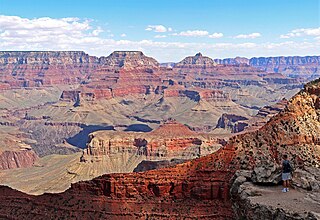
Dunn Butte, is a 5,714 foot-elevation-summit, a minor butte, along a line of three summits along the west drainage of Ninetyone Mile Canyon and Creek. From higher elevation-to-lower, they are Angels Gate, Dunn Butte, and Hawkins Butte. The bases of all three landforms are connected, and Dunn Butte is a south-southwest ridgeline, with the high point prominence at the northeast terminus.

The Alligator (Grand Canyon), is a 5,774-foot (1,760 m)-elevation summit, a large ridgeline butte, connected to, and below Mohave Point (South Rim), approximately 1.5 miles (2.4 km) northwest of Grand Canyon Village, Grand Canyon. The ridgeline trends north, and the lower elevation cliff, the tail of the alligator, turns northwest. The Alligator landform is about 1.0 mile (1.6 km) from the west-flowing Colorado River, and Granite Gorge. The Alligator lies between the Monument Creek (Grand Canyon) drainage, west, and the Salt Creek (Grand Canyon) drainage, east, both short, south tributaries to the Colorado.
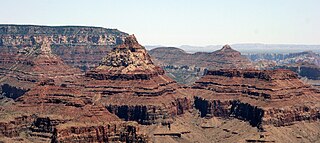
Krishna Shrine is a 6,131-foot-elevation summit located in the eastern Grand Canyon, in Coconino County of northern Arizona, US. The landform is attached at the southwest to the Vishnu Temple massif, about 1.0 mi distant. Krishna Shrine is about 3.0 mi south of the Cape Royal overlook, Walhalla Plateau. A twin landform occupies the southeast of Vishnu Temple, the Rama Shrine. Krishna Shrine towers about 4,000 ft above the Colorado River, about 2.0 miles south. Both Shrines, east and west, and Vishnu Temple, center, are at the headwater drainage of Asbestos Canyon. At the southwest of Krishna, on an extending arm of Redwall Limestone is a short unnamed drainage;. The west flank of Krishna Shrine drains into the long southwest-trending Vishnu Canyon and Creek, which comes from Freya Castle and the Walhalla Plateau, South Rim.

Swilling Butte is a 6,785-foot (2,068 m)-elevation ridgeline summit located in the eastern Grand Canyon, in Coconino County of northern Arizona, United States. The landform is in a group of nearby summits, Colter Butte, west, and Hutton and Duppa Buttes, east. All four buttes are at the north of the east-flowing Kwagunt Creek and Canyon drainage to the Colorado River. Swilling Butte is 3.0 miles (4.8 km) northeast of Atoko Point, East Rim of the Walhalla Plateau, and 4.0 miles (6.4 km) west of the (north)-East Rim, Grand Canyon; the south-flowing Colorado River is west and adjacent to the East Rim. Swilling Butte is a triangular-platform summit of bright-red, tall Redwall Limestone. Being a cliff-former, the Redwall is also a platform-former. The upper platform of the Redwall Limestone supports a remainder-debris of the Supai Group. Of the two lower units, no. 2 is a cliff-former, hard rocks (cliffs), of the Manakacha Formation; the slope-former,, the Watahomigi Formation, forms most of the Supai debris upon the Redwall. Below the Redwall Limestone are members of the Cambrian Tonto Group, the Muav Limestone and the slopes of the Bright Angel Shale.

The Battleship is a 5,850-foot (1,780 m)-elevation summit located in central Grand Canyon, in Coconino County of northern Arizona, United States. The ridgeline, Battleship landform forms part of the western border of Garden Creek Canyon, which contains the Bright Angel Trail down to the Colorado River, and across it to Phantom Ranch. The east border of Garden Creek Canyon is the South Rim, with the overlooks of Grandeur Point and Yavapai Point. The Battleship is 1.5 miles (2.4 km) northwest of Yavapai Point, 1.5 miles due-north of Grand Canyon Village, and roughly 2.0 miles (3.2 km) southwest of the Colorado River.

Topaz Canyon is a linear, narrow canyon in the western Grand Canyon, below the South Rim. It lies in a region of four canyons, and a fifth smaller canyon, all trending mostly northeasterly towards the west-flowing Colorado River, in western Grand Canyon National Park. The name of Topaz Canyon was named by the Board of Geographical Names for precious stones of the region. Topaz Canyon is the southeast border of the linear, and major, forested-landform, Diana Temple; .
The northeast terminus of Topaz Canyon intersects with the outfall of Boucher Canyon and the tract of the Tonto Trail. The Boucher Trail starting in Hermit Canyon,, ends at the termini of both Topaz and Boucher Canyons.

Cocopa Point is a 6,627 foot (2,020 m)-cliff-elevation Point located in the central,, Grand Canyon, Coconino County of northern Arizona, United States. Cocopa Point is 1.1 miles from its closest highest scenic viewpoint, Yuma Point (6,654 ft), located east at Eremita Mesa, at the northeast, overlooking Central Hermit Canyon.
Cocopa Point is in a region of points, at the headwaters of canyons, and landforms below the South Rim. Mimbreno Point lies ~1.7 miles west, and Hermit Canyon and Pima Point, at the west-terminus of West Rim Drive, are about 1.5 mi and 2.0 miles due-east. Cocopa Point is at the northwest of Eremita Mesa; Yuma Point is at the northeast; the mesa lies between Hermit Canyon, east, and Upper Boucher Canyon, west. Cocopa Point is a sheer-walled cliff, sitting at the northwest headwaters of short, Travertine Canyon. At the west of Lower Travertine Canyon, adjacent the Colorado River, sits Whites Butte, about 1.2 miles distant from Cocopa Point.
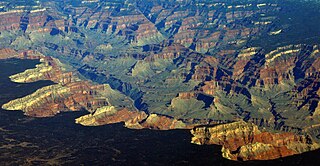
Tuna Canyon is a short, high-angle, descending, narrow canyon in western Grand Canyon, below the North Rim. It lies across Granite Gorge in a region of four canyons, and a fifth smaller canyon, as the Colorado River courses westward around the Point Sublime, , ridgelines. The high-angle of Tuna Canyon, Tuna Creek, creates the Tuna Creek Rapids (Rapid) at the outfall. Tuna Canyon is a short canyon, nestled between the ridges, but just east is the very long drainage of Crystal Creek (Arizona), which drains from the Kaibab Plateau. The Crystal Rapid is adjacent upstream from the Tuna Creek Rapids.


